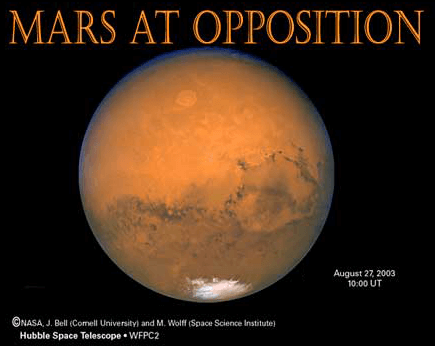Mars at Opposition 2020
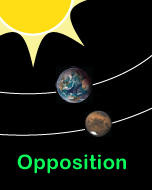
The best time to observe Mars is when it is on the opposite side from the Sun as viewed on Earth as it will be on the night of October 13, 2020. The disk of Mars will be 22.4" and shine at -2.8 magnitude. Once again, Earth catches up with Mars and moves between it and the Sun.
Because of its distance and small size, Mars can be a difficult planet to find in the night sky, because it may appears only as bright as a second magnitude star. Just before opposition Mars becomes very bright and shines all night after the Sun sets. At this time, the two planets will be closest to each other in their orbits. Earth observers can see the full disk of Mars until dawn.
Next Opposition: December 8, 2022
Mars emerged from conjunction in November 2019 but was not readily observed until mid-March of 2020 when the red planet reached 1.7 magnitude and the disk was 5.7". But the new apparition began and Earth and Mars marched toward opposition. Thus began the 2020-21 apparition of Mars that continues until once again the red planet disappears behind the Sun in October 2021.
This close approach between Earth and Mars is not unusual, but part of a regular cycle that the two planets established many years ago. Every 780 days, or roughly 2 years and 50 days, planet Earth passes Mars on its orbital track, overtaking the red planet. Opposition occurs when Earth and is directly between the Mars and the Sun. Just before opposition Mars will be very bright and shine all night after the Sun sets and present a full disk until dawn.
The Earth's orbit is very nearly circular, but Mars' orbit is more eccentric, that is, it varies 0.093 from circular. This means the red planet is much closer to the Sun at perihelion (206 million km) than at aphelion (249 million km) a difference of 43 million km. In comparison, the difference between Earth's aphelion and perihelion distance is 5 million km. These distances vary, of course, and I have used extremes. But those differences mean the distance between Earth and Mars at opposition is variable. The count of 780 (actually 778 days) is considered Mars' "synodic" period. Because of the speed of their orbits Earth travels for 2 years, plus an extra 50 days or so when it catches up again with Mars
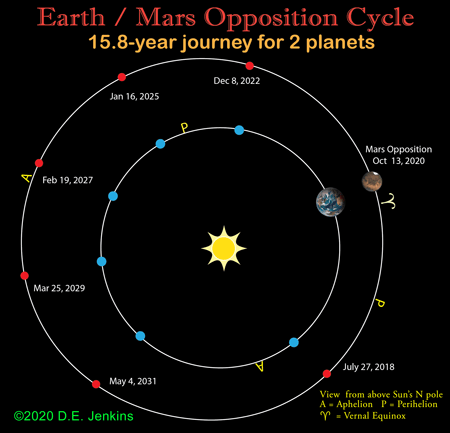
The Earth/Mars opposition cycle can be seen in the diagram. The 2020 opposition is shown at the right, represented by the disks of Earth and Mars. The image shows the solar system as though we are looking down on the Sun's north pole. Although the orbits are shown here with some accuracy, the images of the Sun, Earth, and Mars are not drawn to scale. Both Earth and Mars are shown with the north pole tipped toward the Sun. Other oppositions are represented by blue and red dots. The orbits are both marked with apsides ("a" = "aphelion" and "p" = "perihelion") and the first point of Aries. This marks the 0-degree point for RA in Earth coordinates and therefore helps to orient the orbit. The Earth-Mars opposition cycle repeats for 7 oppositions over a period of 15.8-years. When the cycle has completed 3 times (after 237 or so years) the cycle starts over and the planets again reach opposition at very similar positions where they met in order for 21 times.
In 2020, Mars declination at opposition will be higher in the northern sky and it will make a better telescopic target for northern observers than during the 2018 opposition. When perihelic oppositions occur, they all have similar characteristics. Mars is inclined to its orbit with an axial tilt is 25.2 degrees and it points its southern hemisphere toward the Sun during perihelic oppositions. Mars' orbital motion near perihelion is faster than at aphelion so there is a greater distance between perihelic oppositions as compared to the aphelic oppositions. Mars' orbit and axial tilt means that southern summers are shorter and hotter than southern winters. The seasons are not equal: summer in the north lasts 182 days, while southern summers are 160 days. The seasonal differences mean that Mars north polar cap is larger than the southern cap that may disappear completely during a perihelic opposition.
October 13 Opposition
The October 13, 2020 opposition of Mars will be one of the better oppositions because it takes place when Mars is near to perihelion or the closest point in its orbit from the Sun. This is referred to as a "perihelic" opposition.
As can be seen, Mars just passed its perihelion on October 13. It will be closest to the Earth on October 6, just 7 days earlier. After opposition, the Earth will speed away from the red planet, only to meet up again just before the end of 2022. At that time the distance between the two planets will be 19,381,305 km or 12,042,985 miles greater than it is for this opposition.
When Mars returned to the early morning sky in November 2019, it was located in the constellation of Virgo. It was in conjunction with Spica in Virgo on November 8. Spica is a first magnitude star, but Mars shone at 1.8 magnitude. The conjunction was poorly placed for observations because it was close to the Sun. The disk of Mars was too small to be seen well in telescopes at that time. Mars moved out of Virgo and into Libra in early December still low in the sky and shining at second magnitude. The red planet passed into into Scopius in January 2020, passing 5-degrees north of Antares. Mars could be no challenge to the red giant star that shines at 1.0 magnitude. By mid-month the red planet slipped into the constellation of Ophiuchus, rising about 4:30am EST.
Passing into Sagittarius, Mars was occulted by the 25-day old Moon visible from N. America, south of Canada, Central America, northern S. America, the Caribbean, the Azores, and southern Greenland on February 18. Mars moved through Sagittarius in March, encountering gas giant planets Jupiter and Saturn that had just returned to the morning sky. No time to stop and chat, Mars just whizzed past them like they were standing still. Conjunction with Jupiter in Sagittarius was on March 20 and conjunction with Saturn occurred 11 days later on March 31 with both planets located in Capricornus. Now Mars began to stoke its fiery engine and ended the month at .8 magnitude and a full 6" in diameter. Time for Earth based astronomers to set up telescopes and see what our red companion is up to this apparition. Mars made no pause but raced through Capricornus in April. By May 15, it had grown to 8.1" in diameter and to .3 magnitude, moving hastily into Aquarius.
On June 7th, Earth and Mars reached quadrature with the Sun, the three bodies making a right angle with Earth as the central angle. The red planet is ~29 degrees high and 90-degree elongation from the Sun on that date. It crosses into Pisces on June 24 where it will remain but for a short incursion into Cetus for about 20 days in July. On August 3, Mars will be at perihelion, the position in its orbit that is closest to the Sun in the 687 days it takes to orbit. This is Mars "sidereal" period, that is measured against the stars. It is the amount of time it takes Mars to orbit the Sun using the starry background to fix the time period. When Mars reaches perihelion, the planet often experiences dust storms, sometimes covering the entire planet. On August 9th, a third lunar occultation will occur, visible only in the southern extremes of Earth, Antarctica, southeast S. America, and Ascension Island.
Mars encounters the moon again for another lunar occultation on September 6, visible to observers in southeastern S. America, Ascension Island, and Antarctica. On September 9, Mars will reach its first stationary point, thereafter traveling in a retrograde direction as described below. Mars is at closest approach on October 6, 7 days before opposition. Mars is closer at this time than at the time of conjunction because it is closer to perihelion and is continuing to recede from the Sun. The southern polar cap shrinks at perihelion, maybe even completely diappear during an opposition. On October 13, 2020 at 17:18 U.T., Mars is at opposition and the disk is 100% illuminated. The red planet will dominate the sky and shine from dusk to dawn. Mars will reach its second stationary point on November 15 and resume its prograde motion.
Mars remains in Pisces for the rest of the year, and will move into Aries in early January when it will shine -.11 magnitude. Mars reaches Eastern quadrature on January 31, 2021 when the disk of the planet will be just under 8". Earth has really left the red planet behind as Mars elongation from the Sun is now only 90 degrees. The planet will shine at .45 magnitude on that day. Mars continues to lose magnitude until it is only .84 magnitude when it crosses into Taurus on February 23. By now, most of the astronomers who eagerly awaited the opposition in the summer of 2020 will have moved on to observing other, fainter objects such as the Virgo galactic cluster. By the time Mars leaves Taurus in April of 2021, the red planet will shine at 1.51 magnitude and set long before local midnight. Mars will remain low in the sky and set early until it disappears entirely when the two planets reach Mars conjunction in early October 2021.
Stationary and Retrograde Points
Mars and other outer planets appear to change their direction in the sky as the Earth speeds past them. As Mars goes about its normal orbit, it appears to move through the constellations on the ecliptic in a regular pattern from West to East. This is contrary to the motion of the stars that move from East to West as the Earth rotates. So during the months around opposition, Mars becomes bright, calling attention to itself for astronomers or anyone looking up who can see that bright red warrior. The difference between Mars at its farthest distance and when Earth is passing it is greater than it is for any other planets. At first it seems to behave as usual, but then it does a little dance, and starts to move in the opposite direction or retrograde motion.
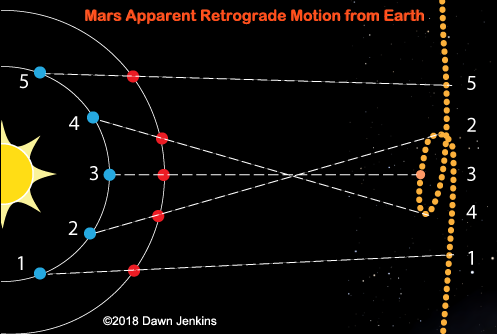
Before retrograde motion begins, Mars seems to stand still. This can be thought of as Earth, coming around the curve of its orbit so that Mars appears to quit moving. This is merely our line-of-sight. It's like being on a train when it is being passed by a faster train. If you are looking out the train window, suddenly you feel like you are moving backwards. Earth and Mars are doing something like this, the blue planet is lapping the red planet on their orbital tracks. On September 9, Mars hits its first stationary point, indicated on the diagram with the number 2. After that it travels in a backward direction (East to West) that is called "retrograde". The night of opposition is October 13 when Mars outshines all the solar system planets except Venus. Now the Sun is directly behind the Earth and Mars is 180-degrees away from it. About a month later on November 15, Mars comes to its second stationary point. Soon Mars resumes its normal course in the sky against the background field of stars that is called "prograde". It's important to remember that Mars never does anything but continue to revolve in its usual counterclockwise orbit. It is only our line-of-sight that makes it seem to move in a loop or sometimes an ess-curve against the background stars.
At position 5, Mars has been left behind and both planets orbit the Sun until their mutual speeds and positions reunite them for the next opposition. The Mars disk shrinks and will continue to do so until Mars disappears behind the Sun in October 2021.
Mars path through Pisces 2020
During the 2020 apparition, Mars moves through the constellation of Pisces. As viewed from Earth, a loop through the constellation occurs as Mars appears to move backward, that is from East to West. During this apparition the loop is open, because Mars will not appear to cross its own path. Mars begins this journey slightly south of the ecliptic (as shown in the image here), but crosses the ecliptic after opposition on December 2.
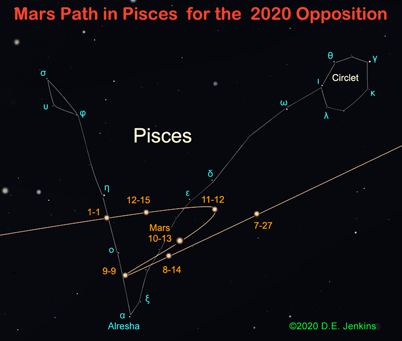
Mars Disk Size
The first disk of Mars on the chart below represents the size and magnitude of the Mars when it first emerged from behind the Sun in 2019. This tiny disk represent the view of Mars when it is far from Earth, presenting a small disk, not quite 4 arc-secs in diameter. As can be seen, the disk will not grow to the grand size it did in 2018, but it will still present a large disk. From the northern hemisphere, astronomers will have a better image of Mars because it will be much higher in the sky.

By August the disk of Mars will grow to the size noted here for the 2025 opposition. By the end of August, the disk will be 17.2", or as large as it will be for the opposition of 2022. Because a large disk will give a better resolution, more images will be made by amateurs and professional astronomers alike. of course, an instrument with a larger aperture will reveal more details on Mars but amateurs with small instruments will be rewarded.
By September Mars disk will be 18.9" and will grow to 21.6" by the end of the month. The disk will continue to grow until it reaches its maximum for this opposition on October 13, 2020. Mars is expected to shine at -2.6 magnitude on the date of opposition. It will then begin to shrink as Earth pulls away from the red planet. By the end of the year, about 79 days later, the disk will be about 11.7". At that time Mars will be about -.25 magnitude.
Some helpful links
For more in depth information on Mars at opposition, go to Astra's Mars Oppositions page.
Find out which side of Mars is visible while you are out viewing the red planet through a telescope. Sky & Telescope magazine features an interactive application, Mars profiler. Use this tool to find out what side of the martian surface is currently in your viewfinder or check up on the time of your observation.
2020 Opposition of Mars - Nakedeyeplanets.com - by Martin J. Powell
Naked Eye planets is a excellent resource for anyone interested in observing Mars or other planets in the solar system. A very detailed description of the path that Mars takes during an opposition is available at the site.
A.L.P.O. MARS Section - American League of Planetary Observers
B.A.A. Mars Section - British Astronomical Association
Hubble Space Telescope Images of Mars
Mars in opposition in 2018 (annotated) - Labels features visible shortly before opposition when there was a dust storm
Stormy Mars in opposition in 2018 - About 2 weeks before closest approach
Mars 2016/2018 side-by-side - Show how different Mars looked in 2016 from 2018 due to dust storm and Mars-Earth circumstances
Animation of difference in Mars orientation, 2016 and 2018 - This shows how different seasons on Mars change the planet's appearance for Earth observers. Because the south pole is pointing toward the Sun, Hellas Basin can be seen more clearly during perihelion apparitions.
One last image that I really love because Saturn was at opposition a month earlier than Mars. The year 2018 brought 3 oppositions in quick succession including Jupiter at opposition May 9. This image shows that Hubble Space Telescope is a planetary instrument as well as a deep sky marvel:
For more observation tips go to this article: What's up article/observing Mars.
For drawing help check here: What's up article/drawing Mars.
Last Opposition: July 27, 2018 | Next Opposition: December 8, 2022
To find out about Earth's missions to Mars, go to Astra's Mars Exploration page.
If you love the red planet as much as Astra does, check out the Astra's Stargate main page on Mars, the 3 Faces of Mars page!
